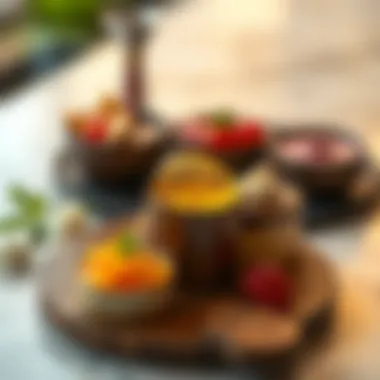Top South Indian Dining Spots in Dubai


Intro
Dubai's culinary scene is as vast as the desert sands, giving food lovers a rich tapestry of flavors and experiences. Among the many cuisines that have found a home in this bustling metropolis, South Indian cuisine stands out with its vibrant dishes and unique culinary traditions. It’s not just about filling up; it’s about savoring each bite and experiencing food that connects to a rich cultural heritage.
From the aromatic spices of Kerala to the delightful flavors of Tamil Nadu, South Indian restaurants in Dubai cater to a diverse crowd, showcasing the true essence of this regional cuisine. This guide will journey through some of the most celebrated South Indian eateries, exploring their specialties, and what makes them a must-visit for both locals and newcomers alike.
Expect to uncover hidden gems that offer more than just food; they offer an experience. Whether you have a craving for dosa or a thirst for filter coffee, this article will surely lead you to your next great meal in the city. The culinary landscape is not just a feast for the palate but also a gateway to understanding the vibrant culture of South India, as seen right here in Dubai.
Preface to South Indian Cuisine
South Indian cuisine is a rich tapestry woven from centuries of culinary traditions, representing states such as Tamil Nadu, Kerala, Karnataka, and Andhra Pradesh. Understanding this cuisine is essential for any food enthusiast, especially those living in Dubai, where diverse cultures converge. South Indian dishes are not just meals but a reflection of the region's history, geography, and the vibrant communities that inhabit it.
Culinary Heritage and Diversity
The culinary heritage of South India can be traced back to ancient times, where spices were paramount, and meals were communal affairs, emphasizing unity and family bonds. One important aspect of South Indian cuisine is its regional diversity. For example, in Tamil Nadu, the use of coconut and curry leaves is prevalent, while Kerala's dishes are known for their distinctive flavor derived from the abundant use of seafood and spices.
Moreover, the influence of age-old cooking techniques, such as fermentation used in making dosas and idlis, adds depth to the dishes. Each state brings its own unique flavor profile to the table, ensuring that even a simple meal is layered with complexity. In short, every flavor tells a story, and every dish reflects the region's unique identity. Understanding these differences is crucial for appreciating the full spectrum of what South Indian cuisine offers, especially in a cosmopolitan city like Dubai that proudly showcases these culinary narratives.
Ingredients and Cooking Techniques
The ingredients used in South Indian cuisine speak volumes about the agricultural richness of the region. Staples such as rice, lentils, and a variety of vegetables form the backbone of most meals. Also, spices play an indispensable role; mustard seeds, fenugreek, and turmeric define the aromas that waft from kitchens, lending depth to the dishes.
As for cooking techniques, they vary from state to state and family to family. Traditional methods include steaming, frying, and slow-cooking. For instance, idlis are steamed to maintain their soft texture, while dosas are crisp and golden from being skillfully spread on hot griddles. This mastery of technique is vital, as it enhances the flavors and textures of the dishes. The distinct cooking styles ensure that meals are not just eaten, but experienced.
In summary, understanding the importance of South Indian cuisine is not merely about the food; it’s about appreciating cultural diversity, culinary techniques, and the ingredients that come together to create memorable dining experiences. This knowledge serves as a foundation for discovering the best South Indian restaurants in Dubai, where the authenticity of these age-old traditions is seamlessly merged with contemporary dining experiences.
The South Indian Dining Experience in Dubai
The South Indian dining experience in Dubai is not merely about the food; it's a vivid tapestry woven with cultural richness and culinary traditions that extend far beyond the bustling city. For many in this cosmopolitan hub, South Indian cuisine serves as a comforting reminder of home, while for others, it beckons with the promise of new and unique flavors. Understanding this experience involves a deep dive into various elements that transform an ordinary meal into an extraordinary event. Here, we will explore how ambiance, decor, service quality, and customer experience play critical roles in shaping the dining journey.
Ambiance and Decor
In the context of South Indian restaurants, ambiance and decor set the stage for an authentic culinary experience. Many establishments showcase elements that reflect the diverse landscapes of South India, be it through traditional artworks or vibrant color palettes reminiscent of spices that are fundamental to South Indian cooking.
Imagine walking into a restaurant adorned with hand-painted murals depicting scenes from Kerala's lush backwaters or the rich history of Tamil Nadu. The lighting is usually warm, giving a cozy feel, making one feel at home. Engaging aromas wafting through the air ignite anticipation as you take a seat, immersed in the space filled with hints of jasmine and curry leaves.
Moreover, the seating arrangements often encourage community, echoing the familial aspect of South Indian dining. Long wooden tables or low seating styles create an inviting atmosphere where sharing a meal is the highlight.
- Colorful Elements: Bright colors are often used in decor, symbolizing the vibrancy of festivals and family celebrations.
- Cultural Artifacts: From brass lamps to vintage kitchen tools, these artifacts offer a glimpse into the culinary heritage.
- Open Kitchens: Some restaurants feature open kitchens, allowing patrons to witness the magic of food preparation firsthand, bridging the gap between chef and diner.
Each aspect of the ambiance aims to replicate not just a meal, but a cultural experience that leaves a lasting impression.
Service Quality and Customer Experience
When it comes to the dining experience, service quality cannot be overlooked. In South Indian restaurants, the staff often plays an integral role in walking you through the menu filled with regional specialties. Their knowledge about each dish comes from a cultural background that enables them to share stories and recommendations that enhance the meal.
Casual yet attentive service is a hallmark. Diners appreciate servers who are ready to engage in discussions about the food, from the best chutney pairing with dosa to the history behind a particular dish. This interaction not only enhances the meal but also creates a connection between the diner and the culture.


- Friendly Staff: Many customers note how the warm, approachable demeanor of the waitstaff makes a significant difference in their dining experience.
- Personalized Recommendations: Regulars often receive tailored suggestions based on past orders, creating a sense of familiarity.
- Feedback Sensitivity: A willingness from management to hear guest feedback signifies a commitment to continuous improvement, elevating overall service.
The importance of service quality cannot be understated. Guests leave not only satiated but also enriched with insights into the culinary delicacies they just enjoyed. All of these factors contribute to an overall experience that resonates long after the last bite is taken.
"Dining in a South Indian restaurant is like stepping into a world where every dish tells a story, and every moment becomes a cherished memory."
From the vibrant ambiance to the caring service, the dining experience in Dubai’s South Indian restaurants encapsulates more than just eating; it embodies a celebration of culture and community, drawing food enthusiasts into its flavorful embrace.
Iconic Dishes to Try
When one thinks of South Indian cuisine, the mind often drifts to a delightful array of dishes that resonate with the heart and soul of a culture steeped in tradition. This section emphasizes the iconic dishes that define this culinary landscape and why they hold a cherished place in the hearts of both locals and expatriates in Dubai. These dishes are not just meals; they represent a blend of heritage, regional variability, and the spirit of community.
Dosas and Idlis: The Staple Choices
Dosas and idlis stand as the cornerstone of South Indian dining. These delightful creations are more than mere food; they symbolize breakfast in both homes and restaurants, cherished by countless families.
- Dosas are crispy, crepe-like pancakes made from fermented rice and lentil batter, served with an array of chutneys and sambar. The texture—such a thin, supple crunch—paired with spices creates a flavor bomb. Simply put, a dosa is best enjoyed hot off the griddle; a little ghee drizzled on top enhances the experience tenfold. Different types of dosas, such as masala dosa or cheese dosa, bring unique flavors to the table.
- Idlis, on the other hand, are soft, fluffy rice cakes that melt in your mouth. They provide a delicate counterpart to the robust flavors of sambar. Often considered a healthy option, idlis are steamed, keeping them light and nourishing.
Both dosas and idlis highlight the art of fermentation, crucial to the preparation. This not only boosts the nutritional aspect but also enriches the flavors, making these staples everlasting favorites.
Rice Varieties: Biryani and Pongal
South Indian cuisine dazzles with its diversity of rice dishes. Among them, biryani and pongal stand out, each bringing layers of flavor and culture.
- Biryani, particularly hyderabadi biryani, is a grand affair. It typically features long-grain basmati rice, marinated meat, and a chorus of spices, resulting in a dish that's aromatic and grand. In Dubai, biryani is not just food; it is an experience—often served at gatherings where families bond over shared plates. Each bite reveals the depth of the spices used, as well as the care taken in its preparation.
- Pongal, contrastingly, is a very humble offering. Often made with rice and moong dal, it is seasoned with cumin, pepper, and ghee. While biryani signifies celebration, pongal embodies comfort and simplicity. When enjoyed in its traditional setting during festivals, the dish gains even more significance, representing abundance and gratitude.
Both rice varieties, whether rich or simple, reflect the essence of community and feasting in South Indian culture. They showcase how rice transitions from everyday sustenance to culinary splendor, wrapping history in every grain.
Sambars and Rasams: Flavorful Soups
Sambars and rasams are not just sides; they are vital elements of a meal that elevate the dining experience exponentially.
- Sambar is a lentil-based vegetable stew, often spiced with tamarind and a fragrant mix of spices. It serves as a vibrant complement to rice or dosas and is prized for its tangy richness. The inclusion of seasonal veggies in a warm bowl of sambar showcases the connection between food and the land.
- Rasam, synonymous with comfort, is a sour and spicy broth, subtly flavored with tamarind, tomato, and various spices. Traditionally, it’s consumed as a soup but often finds its place mixed with rice. Rasam acts as a palate cleanser, refreshing and delightful, especially on a sweltering Dubai day.
When one relishes these dishes, it’s not merely about nourishment but an experience—tingling flavors of cumin, coriander, and tamarind tickling the palate. They speak volumes about the culinary art that South India offers.
"The heart and soul of South India are encapsulated in its food, where every dish tells a story rich with culture and tradition."
Top South Indian Restaurants in Dubai
When it comes to immersing oneself in the flavors of South India, dining out in Dubai presents a fantastic opportunity. The city isn't just a hub for skyscrapers and shopping malls; it also boasts a vibrant culinary scene that celebrates rich cultures and traditions. South Indian cuisine, known for its intricate blend of spices, unique textures, and diverse offerings, has found a proud place among Dubai’s gastronomic gems. This section explores some of the best South Indian restaurants in the city, highlighting not only their standout dishes but also the experiences they offer.
Restaurant A: A Culinary Gem
Signature Dishes
The signature dishes at this establishment are nothing short of a revelation. Focused primarily on authenticity, each item on the menu reflects the unique regional flavors of South India. Melting dosas and fluffy idlis served with fresh coconut chutneys and spicy sambar transport diners straight to the heart of Tamil Nadu. Another highlight is the Rawa Masala Dosa, a crisp, savory pancake filled with spicy mashed potatoes. The use of traditional cooking methods and ingredients makes these dishes a popular choice; they embody comfort food at its best while satisfying the cravings of both locals and expats. The key characteristic here is the freshness of ingredients, which shine through in every bite.
Customer Reviews


Customer reviews play an integral role in understanding the restaurant's approach to service and food quality. Guests consistently rave about the warm, welcoming staff and the cozy ambiance. Buyers often remark on not just the food quality—"I felt like home, every bite was nostalgia!"—but also about how attentive the wait staff are without being overwhelming. This focus on customer satisfaction distinguishes this restaurant from others in the bustling Dubai food scene. Collectively, these reviews establish a solid reputation that attracts curious diners trying to discover authentic South Indian flavors.
Location and Accessibility
Location matters greatly in Dubai's competitive dining sector. This restaurant enjoys a prime spot in a bustling area, making it easily accessible. Close to public transport, it’s just a stone’s throw away from major metro stations. The ample parking space nearby is another boon for those driving in, as figuring out where to park can often be a hassle in the city. This restaurant's strategic placement, coupled with an inviting sign, creates an environment that attracts foot traffic and recommendations, serving as a beacon for anyone craving South Indian cuisine.
Restaurant B: Tradition Meets Modernity
Dining Experience
The dining experience here is a delightful blend of tradition and innovation. From the moment you step in, the decor strikes a chord—traditional artwork juxtaposed with contemporary design elements. Soft Indian music hums in the background, creating a relaxed atmosphere that allows diners to enjoy their meal at a leisurely pace. The service is well-organized, with each staff member knowledgeable in both food offerings and pairing suggestions, making the dining experience seamless. Patrons appreciate how every visit can feel like a special occasion, with unique twists on classic dishes inspiring exploration of both old favorites and new creations.
Special Events
Special events, such as themed nights and festival celebrations, enhance the appeal of this restaurant. Diners can enjoy special menus that celebrate significant South Indian festivals like Onam, where traditional 'sadhya' (feast) is served. These events allow food lovers to experience a deeper cultural connection. The atmosphere changes beautifully during these occasions; it’s vibrant, filled with joy, and fosters a sense of community among those who gather to appreciate food and tradition. This adds a dynamic layer to the dining experience, making it not just a meal but a cherished memory.
Reservation Tips
Making reservations can be savvy, especially during festive seasons or weekends. The restaurant often draws large crowds, and booking in advance helps ensure a spot at the table. Utilizing their online reservation system is a great strategy, as it allows diners to choose preferred timings and even special requests for occasions like birthdays or anniversaries. Checking peak dining hours can also help diners plan accordingly, depending on how busy they prefer their dining environment. Most importantly, this tip can save potential disappointment, especially for enthusiasts who cannot wait to dive into the taste of Sri Rangam dosa.
Restaurant C: Authentic Flavors
Chef’s Recommendations
Every chef has their favorites, and here, the chef's recommendations reveal a treasure trove of culinary delights. The highlighted dishes often encompass seasonal ingredients and reflect the chef’s journey through South India. Each recommendation is designed to offer an authentic taste that may otherwise get overlooked by first-time visitors. From steaming bowls of bisibelebath to rich payasam, these dishes not only taste amazing but also tell a story, one infused with the chef's passion and heritage. Recommendations carry weight, guiding diners to make informed choices while enhancing their overall experience.
Meal Presentation
Presentation is key, especially in a dining landscape where first impressions matter. The way meals are plated speaks volumes about the restaurant's approach to cuisine. Here, dishes are carefully curated to appeal visually before they even touch the palate. Vibrant colors and artistic arrangements make each plate inviting. Those key characteristics elevate the dining experience from merely eating to indulging in a visual feast. However, while aesthetics are impressive, they are complemented by the wonderful flavors locked within each dish, ensuring diners are engaged in a multi-sensory experience.
Takeout and Delivery Options
In today’s fast-paced world, takeout and delivery options offer flexibility for customers who may not always dine in. This restaurant excels in both aspects, providing carefully packaged meals that maintain their warmth and flavor. The efficient delivery service complements the busy lifestyle of many in Dubai, allowing them to enjoy delicious South Indian food in the comfort of their homes. Notably, their commitment to quality doesn’t falter in takeout; customers rave about how meals retain their authenticity even when consumed off-site. In this context, takeout represents not just convenience, but also a way for diners to share authentic Southern meals, enhancing the restaurant’s reach and popularity.
Dining Trends in South Indian Cuisine
The world of South Indian cuisine is constantly evolving, mirroring broader dining trends and the preferences of discerning food enthusiasts. Understanding these trends is crucial, as they not only enhance the experience but also reflect the growing appreciation for this culinary form. An exploration into dining trends provides insights into how traditional dishes can be reimagined while preserving their inherent flavors.
Fusion Creations: Embracing Diversity
In the past decade or so, there has been a notable rise in fusion cuisine, particularly in cosmopolitan cities like Dubai. South Indian food has smartly slid into this trend, blending its rich history with flavors and techniques from diverse cuisines. For instance, imagine a masala dosa filled with a zesty guacamole instead of the traditional potato filling. Such innovative twists don't stray too far from the roots, yet they bring a fresh perspective to familiar dishes.
Many restaurants have started adding items like dosa tacos or idli sliders to their menus, serving them with dips that range from tamarind chutney to even spicy aioli. This openness to experimentation has led to a new kind of appreciation for South Indian food among those who may have found traditional variations somewhat intimidating or unfamiliar. Not only does this encourage culinary exploration, but it also positions South Indian cuisine as a player in the modern gastronomic landscape.
"In the essence of each fusion dish lies the ability to respect the original while pushing the limits of creativity."
Health-Conscious Options: Vegetarian and Vegan Choices
Health-conscious dining trends also play a significant role in shaping the offerings at South Indian establishments in Dubai. With a growing emphasis on vegetarian and vegan diets, many restaurants have revamped their menus to cater to a wider audience. It’s not just about providing rules; it’s about showcasing the vast array of flavors and textures that South Indian vegetarian food can offer.


Traditional dishes like sambar, rasam, and various vegetable curries do a fantastic job of being hearty yet healthy. Ingredients like lentils, fresh vegetables, and coconut are packed with nutrients and are naturally suited to vegetarian and vegan diets. Moreover, many chefs have started to focus on organic and locally sourced ingredients, ensuring that diners not only get wholesome meals but also support sustainable practices.
As people become increasingly aware of what they eat, having options that don’t compromise on flavor while being healthy is essential. By blending nutrition with the core aspects of South Indian cuisine, restaurants are reaching a demographic that craves both taste and health in their meals.
In summary, staying attuned to these dining trends in South Indian cuisine allows restaurants to appeal to a broad clientele, enhancing the overall culinary experience while keeping the essence of tradition intact.
Cultural Significance of South Indian Food
South Indian cuisine is not just about feeding the stomach; it's a vibrant component of culture, woven into the fabric of everyday life. Understanding its cultural significance helps one appreciate the dishes on a deeper level. Whether it’s the traditions surrounding food preparation or the rituals linked to certain meals, every aspect of South Indian food tells a story. The shared experience of food reflects customs, family values, and regional histories, making every bite carry significance.
First, let's explore what makes festivals so special when it comes to food.
Festivals and Food: Celebratory Dishes
In South India, festivals are synonymous with food. During celebrations like Pongal, Onam, and Diwali, special dishes ignite joy and foster communal bonds. For instance, Pongal, a dish made from rice and lentils, is integral to the festival of the same name, symbolizing prosperity and gratitude. Each region offers unique specialties—Kerala prepares a grand feast called Onam Sadhya, which typically consists of over twenty dishes served on a banana leaf, allowing people to savor a variety of flavors in one sitting.
"Food in South Indian culture is an expression of joys and sorrows, often serving as the glue that holds families together during significant celebrations."
During festivals, dishes often showcase an array of colors, flavors, and textures, encapsulating the rich agricultural bounty of the region. Spices like cardamom, turmeric, and cumin find their way into the kitchens, elevating the flavors and making experiences unforgettable.
Moreover, food prepared for festivals often has a religious dimension, reflecting beliefs and values. Offerings made to deities during ceremonies often include traditional sweets and savory items, reinforcing the connection between food and spirituality in South Indian culture.
Family Traditions: Home-Cooked Meals
Food is at the heart of family traditions in South India. Home-cooked meals often represent love, care, and the introduction to various cooking styles passed down through generations. Each family often has its trademark recipes that showcase their unique heritage. An Idli and Vatral Kuzhambu on a Sunday morning can evoke nostalgia, connecting one with childhood memories, every bite becoming a tribute to family and tradition.
Cooking is often a communal affair, where family members participate together. It is not just about the taste but also about the experience of gathering in the kitchen, sharing stories, and creating bonds. In many households, the grandmother's recipe becomes the gold standard, as everyone aims to replicate her magic in the kitchen, passing down flavors and techniques with love.
Cultural gatherings, where families come together to celebrate birthdays, anniversaries, or the completion of festivals, always showcase a feast. Dishes like biryani, sambar, and various chutneys come out to offer variety, ensuring the cohesiveness of family ties through shared meals.
In essence, South Indian food transcends sustenance; it is an evolving narrative reflecting history, community, and familial warmth that is both profound and unifying.
The interplay of festivals and home-cooked meals within this cuisine enriches the understanding of South Indian culture as it is observed in Dubai's culinary landscape.
Closure and Recommendations
The realm of South Indian cuisine in Dubai offers a wealth of flavors and experiences that cater to diverse palates. This exploration not only shines a light on the restaurants that encapsulate this culinary art but also underlines the significance of seeking authenticity in every bite. As you navigate through Dubai's buzzing food scene, remember that the essence of South Indian cooking lies in its rich heritage and the intricate use of spices. Choosing the right restaurant isn’t just about dining; it’s about immersing yourself in a cultural experience that celebrates tradition, family, and the joy of sharing food.
Why Authenticity Matters
When you are after the true taste of South India, authenticity feels like the golden ticket. It’s crucial to look for places where the chefs are passionate about keeping traditional techniques alive, utilizing ingredients that are true to the region. Not only does this reflect respect for ancestry, but it also leads to a richer, more satisfying meal.
Consider Your Options
- Ambiance: Think about the experience beyond food. The decor and the ambiance of the restaurant can significantly impact your overall dining experience.
- Menus: There should be a variety of dishes available that reflect the region's diversity. Specific menus often highlight seasonal ingredients, making your meal fresh and relevant.
- Service: Good food deserves to be paired with equally great service. Look for places known for their attention to detail and customer service.
When you are out exploring, keep the local community in mind. Often, finding hot spots recommended by residents leads to the most rewarding experiences. Engage with staff and ask for their recommendations. After all, who knows a menu better than the people who serve it daily? You might just stumble upon hidden gems that go beyond the usual fare.
"Food is not just about sustenance; it is a bridge that connects cultures and communities."
Final Thoughts on Seeking Authentic South Indian Cuisine
As we wrap up this culinary journey, let’s take a moment to reflect on how important it is to savor each experience. Authentic South Indian cuisine is more than a meal; it’s a story, a narrative painted with spices and flavors. In a city as diverse as Dubai, there is no shortage of opportunities to delve into this rich culinary heritage.
Be mindful of how often food trends change and how they can influence what’s on offer. While fusion dishes have their charm, the foundational flavors of traditional South Indian recipes remain timeless. So, make your choices wisely, and embark on a flavorful adventure that celebrates the roots of this vibrant cuisine.
In summary, when you're seeking South Indian delights in Dubai, focus on authenticity, variety, and a warm atmosphere. Whether it’s a bustling restaurant or a cozy corner eatery, each place has a unique story to share, waiting to be savored one bite at a time.











